There's a lot of boletes out there to hunt, and they can be mystifying to try and identify if you're trying to make a meal out of them. Scaber Stalks, also known as Leccinums, Aspen or Birch Boletes, are one of the more easy boletes to identify. But, there's a few things you need to know if you want to cook them safely.
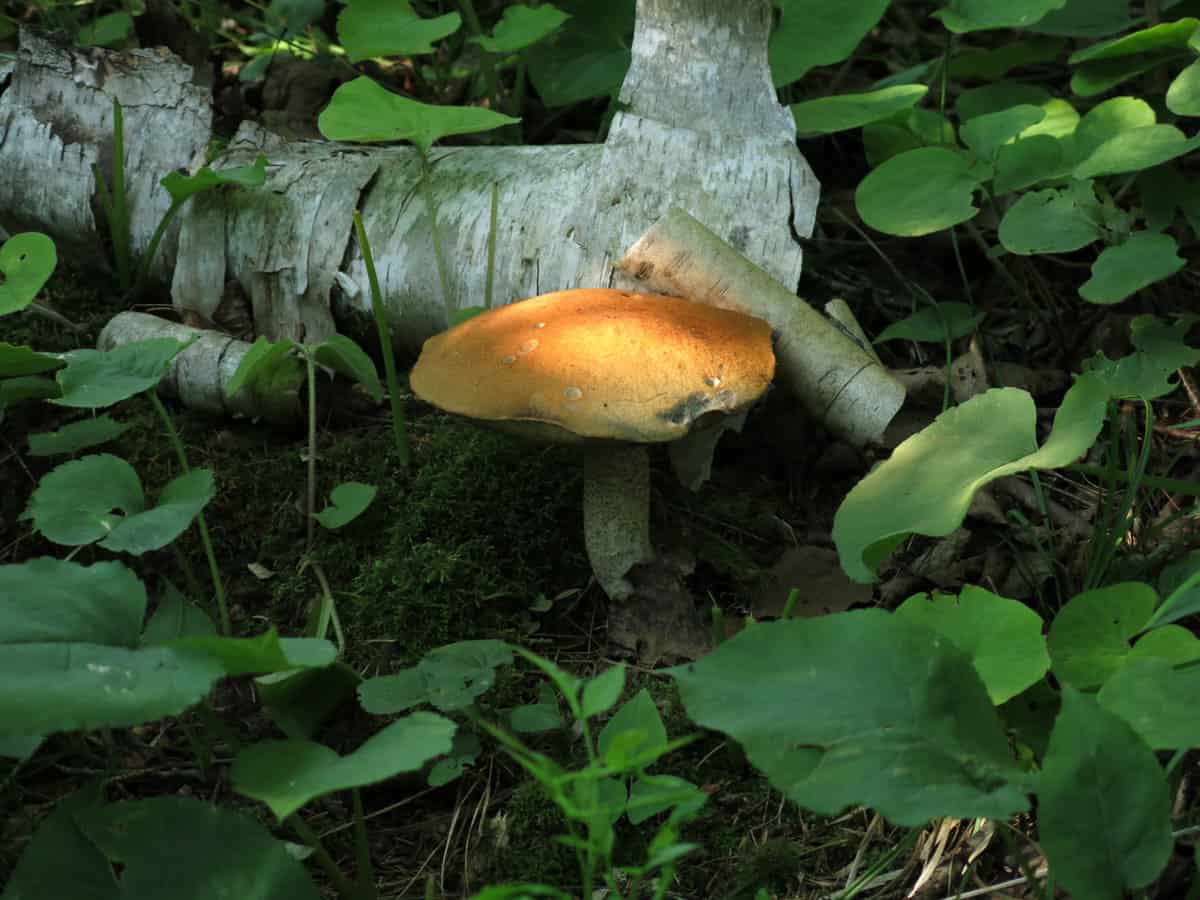
Well, hold on, saying that they're easy to identify though is a little misleading, but, basically, It's easy to tell if a mushroom is a Leccinum, but it can be difficult to tell exactly which species of Leccinum it is.
For the most part, with the exception of one species I'll go over, Leccinums tell you immediately what they are by the markings on their stems, also known as "scabers".
Scabers
The picture below is a great example of typical-looking Leccinum. Notice the scabers, or black markings on the stem, which are a dead giveaway.

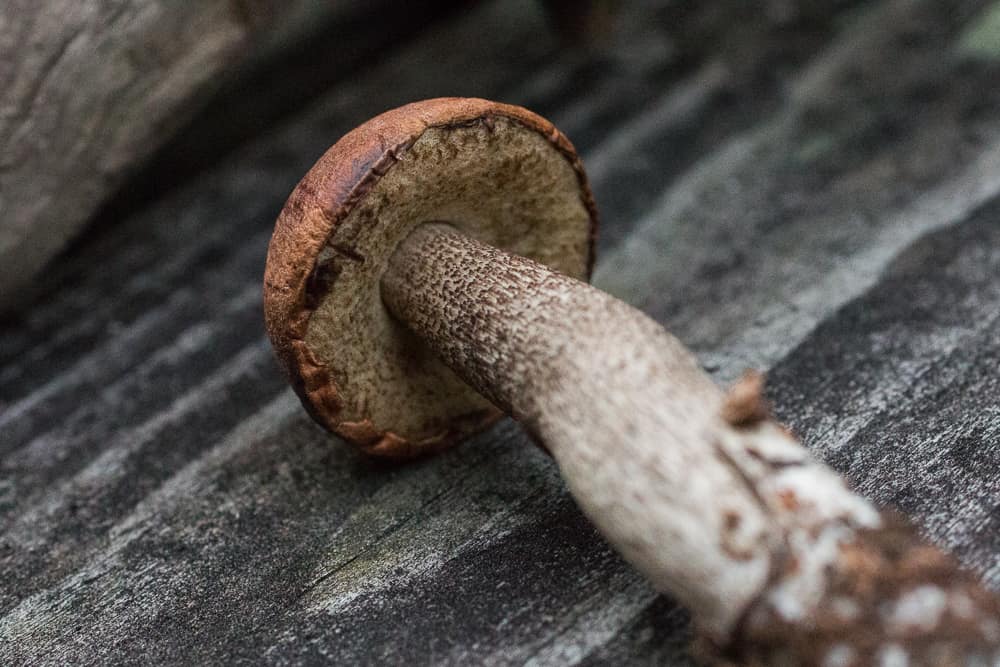
Exceptions to the scaber rule
Of course, mushrooms don't know that they're supposed to play by rules, so, of course there is an exception to the scaber ID trick. Luckily, so far these are the only one I know of, and once you've picked them a couple times, they're easy. They're name is Hemileccinum subglabripes, or what I call the yellow Leccinum, and they are the only mushroom I know of with the word Leccinum in their name that doesn't have the black markings on the stem.
Everything else is similar though: they're heavy, weighty mushrooms, and they enjoy the same habitat as other Leccinums. They're also good eaters, and have a great resistance to bugs. See more pictures of these here.
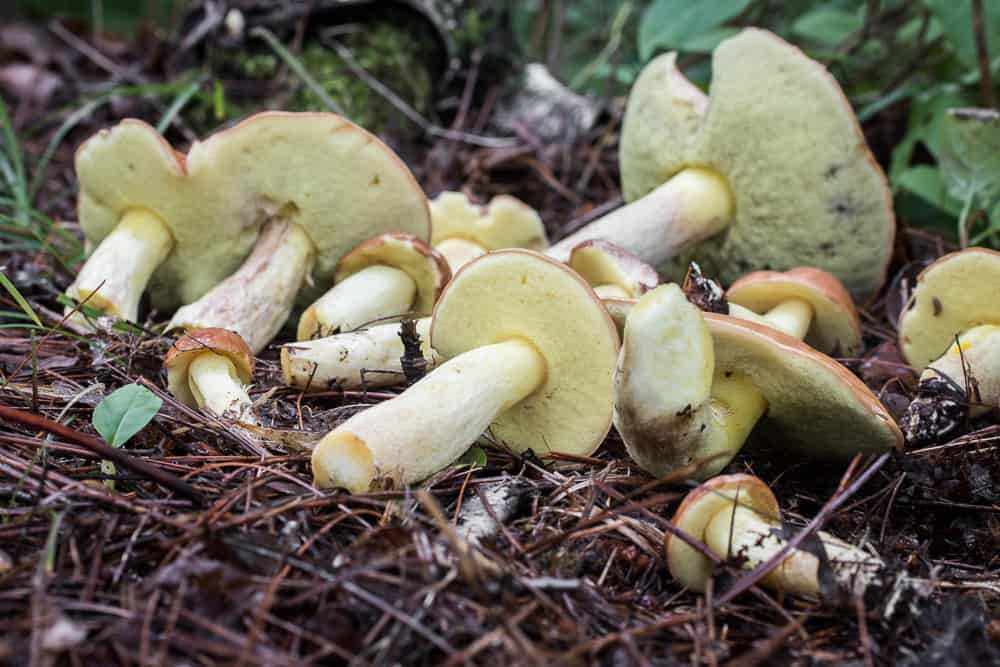

Habitat
These will start to fruit in the summer where I'm from in Minnesota, just as the chanterelles start to fruit in early July.
As their name implies, more often than not when I see them, they're growing with aspen or birch, although I've seen species with the dark red cap growing in stands of pure Norway pine as well in Northern Minnesota. The species below I usually see in areas that include both aspen and oak.
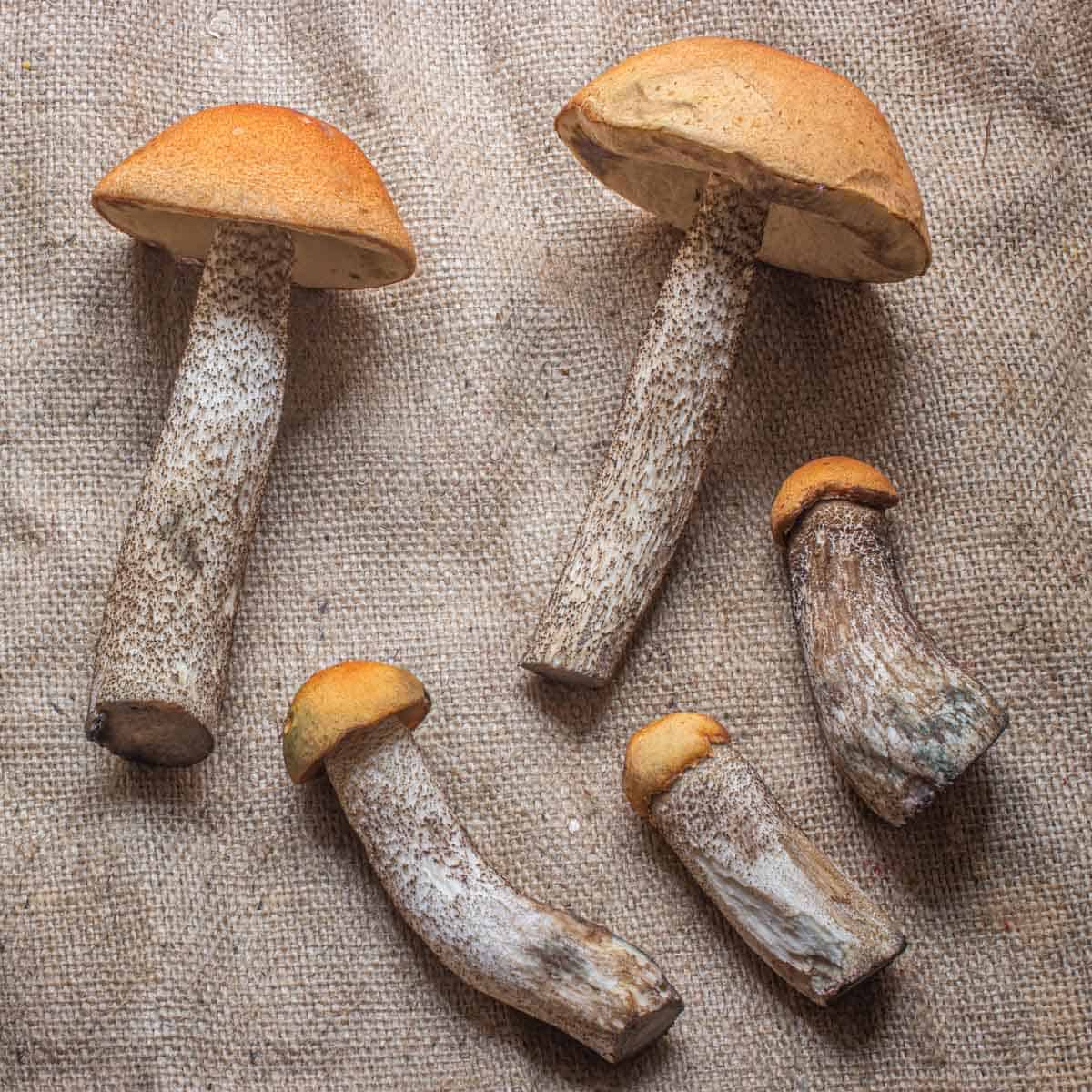
Orange-Capped Leccinums: edible, poisonous? Or Both?
Boletes in the Leccinum family have been used as a food for a long time, and they're especially popular in Eastern Europe, and with Immigrants in the United States from those countries. But, current field guides do not recommend orange cap-leccinum mushrooms for the table, citing a number of different poisoning cases over the years.
However, just because a few people were poisoned, in my mind, doesn't necessitate that we toss out a group of mushrooms that are delicious to eat. Modern, alarmist claims that certain food plants and mushrooms that have been known to be eaten for a long time by different groups of humans, need to be taken into consideration, and balanced, with ethnobotanical evidence and accounts of consumption. Modern science is extremely valuable, but so are the human food traditions that often predate it by thousands of years.
"It wasn't the mushrooms fault that I didn't cook it long enough"
I should know, as Leccinum is the only species of wild mushroom I've poisoned myself with. The thing was, I had been eating Leccinums cooked fresh, and I didn't cook them long enough.
After a night full of horrible vomiting and cramps, I learned my lesson. It wasn't the mushrooms fault that I didn't cook it long enough. I dry ever Leccinum I harvest now, since, besides improving their flavor, it negates gastro-intestinal worries. Dehydrating, in my opinion has been, and always will be a first line of defense against the most common, mild toxins found in edible mushrooms.
It might sound weird, but orange-capped Leccinum are what I would call technically poisonous, and edible at the same time, just like Morchella and Gyromitra mushrooms. It's my opinion that orange capped Leccinums, after dehydrating, are just as safe (not to mention rich and delicious) as any most other wild mushrooms you'd like to eat. To be clear: I dehydrate every Leccinum I harvest.
Cooking
There are definitely a couple tricks to know here. The first thing I'll mention is that I don't typically eat them fresh unless they're very small buttons. I prefer to dry them, since I think it concentrates their flavor, and also bypasses any danger of under-cooking. When eaten fresh these are good, but a bit mild.
Separating the caps from the stem
One thing you'll notice straight away, is that these can be heavy, dense mushrooms, well, the stem that is. As the mushrooms age, the stems stay very firm (and often bug-free), but, the caps can become flimsy, and often full of intruders.
This means that the cap and stem will cook at different rates, so you'll need to add the stalk to the pan first, before adding the cap, if you want to do something like saute them, which I generally don't do any way.
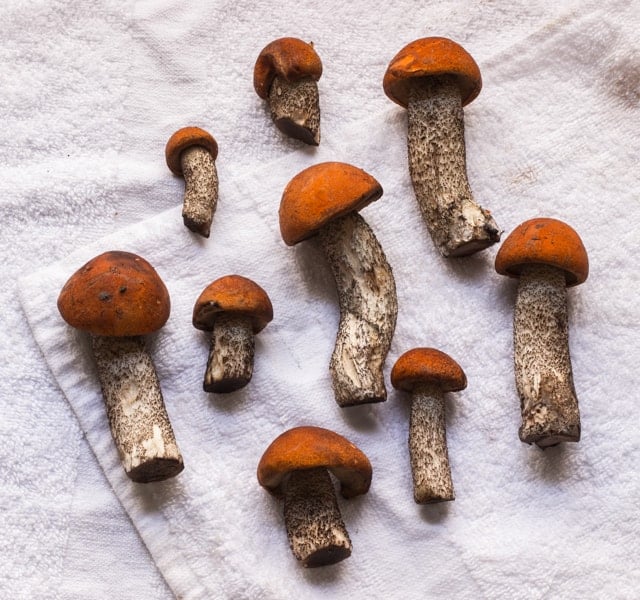
Recipes
Here's some favorite recipes I like specifically for Leccinums, or boletes in general

Jack
Does anyone understand the science behind dehydration and mushroom toxicity? The typical dehydrator is not very hot, which means it is likely that heat is not the catalyst for the chemical change to toxicity. People have mentioned small insects, that look like pieces of dirt, live in the cap. Perhaps, dehydration is sufficient to kill these insects and cooking long enough also kills these insects? I have also seen an academic article discussing the potential for heavy metal poisoning in Leccinums, which dehydration would not solve.
Alan Bergo
If you're looking for a scientific article I don't have any, but it is simply a well known fact that drying mushrooms makes them easier to digest than fresh and basically impossible to undercook. Another thing to take into account is that dried mushrooms are usually used for soup and things that are long cooked, which provides extra security against undercooking. As far as heavy metal concentration by mushrooms, it should be pretty well documented that mushrooms will concentrate heavy metals if they're in an area that's contaminated with them, which makes it an environment issue, not a species issue.
Lilly
but also worthwhile to think about because you could cold-dry things too (you do that with psychedelic mushrooms, according to my friend SWIM, for kind of the opposite reason you should use a regular hot dehydrator on edible mushrooms)
Lilly
Not about insects. Toxins. Would take a lot of knowhow to know specifically why, but little to imagine: water is a buffer and it will keep things under 212F. A lot of enzymes and other molecules denature in the 100-200F zone, some maybe higher than 200F. Cooking is complicated but dry things get hot easier than wet things! Wet things have a lot of mass and like to stay the same temp inside. Makes it hard to be reliable about thorough cooking.
Lena
I have an Eastern European background and now live in Western Canada. I have been picking and eating these for years here. Usually soups or fried with potatoes and onions. Never got sick, myself or anyone else. They are usually thoroughly cooked though, just by virtue of the time it takes to make these dishes. Back in Eastern Europe, people also picked them all the time, and I'd never heard of anyone getting sick. Dehydrating was popular as well although I never do that now.
Peter
Hi, Alan. I haven't harvested these in a while, but the general guidelines for eating red scaber stalks where I live here in Norway say to always cook them at no less than medium-high heat for 15 minutes prior to consumption. When I would pick them, I would first cook them per the guidelines, and then move on to dehydrating what I wasn't able to eat at once.
Sadly, I can't say the results were overwhelming, hence why I've proceeded to passing them by. The combination of blackness and sliminess of the cooked scabrums just didn't work up that much of an appeal for me, and with the subsequent dehydration they would just wind up like these hard, black, nondescript mushroom bits.
Just to be absolutely certain, are you saying the cooking step isn't needed if I'm dehydrating them, and that dehydrating only works even better than cooking from fresh? That leaves a good chance I'll be taking an interest in these again. Thanks for sharing your knowledge:-)
Alan Bergo
Hi Peter. I'm saying that I dehydrate the mushrooms and then I cook them again, be it in soup, or even ground as a crust for meat. Whatever I do though, they are always cooked in some way after drying. Drying also improves the texture, as you noted about the sliminess there, although browned well in a pan I've found them ok. They're just a lot better after drying, as some mushrooms are, especially boletes.
Steve Woolston
Hello Alan, I have been picking these and dehydrating these at 145 for 8 hours. From there I’ll add them to soups and stews of course but if I wanted to infuse soy sauce can I just add the dehydrated shrooms or do they require additional cooking beforehand? Does dehydrating have the same effect as cooking? And if so does dehydrating have to take place at a specific temperature to make these edible? Thanks for reading
Alan Bergo
You could use them to infuse soy sauce, but I would add a splash of water and bring the soy sauce to a boil to sterilize it before using. Dehydrating has a similar effect to cooking, the exact temperature doesn't seem to have as much of an effect on potential GI issues, as much as if the mushroom has been dried or not.
Vera
Ha, I am one of those Eastern Europeans, now in WI. We would add dried leccinums (don't remember ever eating them otherwise) to a traditional Christmas dish, "black kuba". Basically a barley mushroom casserole, with a lot of marjoram and garlic. A favorite mushroom dish, besides the "kulajda" soup (potatoes, dill !). We love mushrooms here. Thanks for what you do, we love your book. Hope the mushroom one is in the making...
Alan Bergo
Thanks Vera.
Don
Aspen/Birch Boletes or simple "Red Caps" whatever you call them are DELICIOUS!!!, we have Dried them Pickled them, Fried them...
HOWEVER... Always if not dehydrated they are boiled for a long time before pickling or frying..
Never Got sick, only got FULL :)... as we find them by the Dozens but we prefer them "Short and Fat" usually when larger they get soft and wormy.
and if you have not tried Cream sauce made from Aspen Boletes that were dehydrated... then YOU Have not LIVED!!!
Alan Bergo
Noted on the cream sauce. 🙂
Vera
Does dehydrator temperature matter? My sons got sick from using my ground Bolette powder and I know there were the aspen bolettes. I’m very careful.
Alan Bergo
Hi Vera, thanks for commenting. Sounds like your sons have an allergy to them, unfortunately. How were the mushrooms prepared?
Michelle Rich
I am so glad I read this before trying the red-capped leccinum I picked a couple of days ago. I know I probably wouldn't have cooked them long enough. They're in the dehydrator now, along with a boletus russellii that I'm hoping will improve in flavor and texture. I've never tried them, but I'm a little nervous reading about it because I'm not a fan of soft or slimy. Thanks for the info, super appreciate it!
Alan Bergo
Thanks Michelle. Glad it was helpful. The russellii aren't great fresh but I just dried some in a blend.
Meagan McAleese
Ive been eating dozen of these all summer! When they get older/bigger, they get some tiny white worms/black slinky bugs but these seem to fry up tasty as well! The fabulous part is that when you fry them, everything turns black and if its fried long enough, everything is safe to eat!!
Alan Bergo
Yes I really like them.
Jeramy
Will freeze drying have the same effect on the toxins as dehydrating?
Alan Bergo
Yes.
Omar Ruiz Diaz
How to dry this mushroom ? I eat it several times, in fact, today I did...
Alan Bergo
Get a dehydrator, they work well.
Ellie
Alan Bergo, you're absolutely right.
I went picking these 3 days ago. I slice them all , then dehydrate them, then, I powder some as needed, and add the powdered mushrooms while cooking soups, ground meat (to make meat loaf)or meat ball or sauces.
How do you preserve yours?
I use method I learned from the "old country" while growing up in Europe as a child 🙂
Pimp
I eat this mushroom all the time fresh if I can. They're tasty and I've never been sick. They also come in big numbers that I dehydrate alot as well. Made a homemade dehydrater out of a box some window screen a light bulb and a small fan. Works great. I'm off to pick more now. Also I think most of the poisoning is from the euro group which I suspect is a different species all together.
Joe
At what temp do I need to dehydrate these to eliminate the toxins?
Alan Bergo
The temperature isn't important as long as they're cracker dry. Anywhere from 100-145F. Of you could slice them thinly and dry them in the sun. You're going to be cooking them, presumably in a liquid that's simmered or boiled which is an added precaution here.
James
I have recently spied these in an aspen grove I take care of. I have been researching these aspen boletes to identify them as edible. I have been cautiously eating a small part at a time. I have had them fried and dried. So far I have consumed two 1/4 " slices of the whole mushroom. No ill effects. They smell and taste so good.
I live in the middle part of Saskatchewan. Your report was encouraging.
Kd
I have the birch bolete growing on my property and it is delicious. I have also eaten the bicolor bolete and it too is delicious. I love the bolete mushrooms. They are very choice. And to think, the Italians call them porcini and some consider them to be pig food. Maybe I should ask them if they will let me have their boletes.
Chris
Porcini means little piggy and refers to the king bolete. These patches are highly coveted. Suillus mushrooms are fed to the pigs.
Lee Einer
And a horrible waste it is to feed them to the pigs!
Where I live, they call suillus "slippery Jacks" and consider them not worth harvesting. Russians call them "chickenfats," and dote on them.
The sticking point is their high water content, which makes them "slimy" when cooked.
Drying them makes the water content moot. I actually like to lacto-ferment them, and then dry the solids or add more goodies and puree the solids into a mushroom catsup.
The real gold is the lactofermented mushroom juice, which is a fabulous flavor addition to all sorts of things, salty, sour, shroomy and complex.
Noah W
Do you cook them before you lacto-ferment them? It sounds very nice, I want to try this out.
Alan Bergo
With this species you would definitely cook them before hand. If they're undercooked they can make you sick.
Srbodlak
Porcini means piglets, and Italians love them as theu love the real piglets.